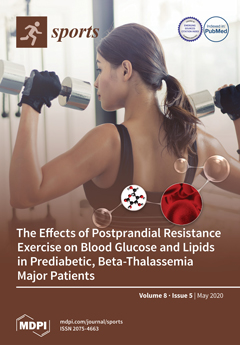In professional academy rugby league (RL) players, this two-part study examined; (A) the within- and between-day reliability of isometric mid-thigh pulls (IMTP), countermovement jumps (CMJ), and a wellness questionnaire (
n = 11), and (B) profiled the responses with acceptable reliability (no between-trial
[...] Read more.
In professional academy rugby league (RL) players, this two-part study examined; (A) the within- and between-day reliability of isometric mid-thigh pulls (IMTP), countermovement jumps (CMJ), and a wellness questionnaire (
n = 11), and (B) profiled the responses with acceptable reliability (no between-trial differences and between-day coefficient of variation (CV) ≤10% and intraclass correlation coefficient (ICC) ≥0.8) for 120 h (baseline: −3, +24, +48, +72, +96, +120 h) following RL match-play (
n = 10). In part A, force at 200, and 250 ms, and peak force (PF) demonstrated acceptable within- (CV%: 3.67–8.41%, ICC: 0.89–0.93) and between-day (CV%: 4.34–8.62%, ICC: 0.87–0.92) reliability for IMTP. Most CMJ variables demonstrated acceptable within-day reliability (CV%: 3.03–7.34%, ICC: 0.82–0.98), but only six (i.e., flight-time, PF, peak power (PP), relative PP, velocity at take-off (VTO), jump-height (JH)) showed acceptable between-day reliability (CV%: 2.56–6.79%, ICC: 0.83–0.91). Only total wellness demonstrated acceptable between-day reliability (CV%: 7.05%, ICC: 0.90) from the questionnaire. In part B, reductions of 4.75% and 9.23% (vs. baseline; 2.54 m∙s
−1; 0.33 m) occurred at +24 h for CMJ VTO, and JH, respectively. Acceptable reliability was observed in some, but not all, variables and the magnitude and time-course of post-match responses were test and variable specific. Practitioners should therefore be mindful of the influence that the choice of recovery monitoring tool may have upon the practical interpretation of the data.
Full article






